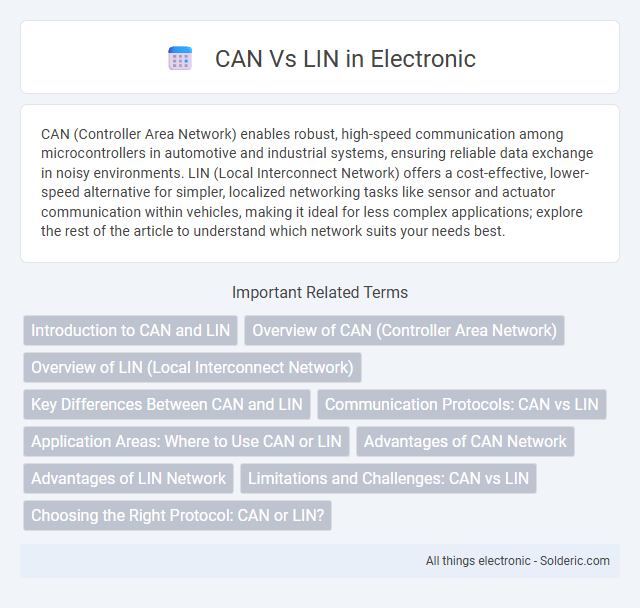CAN (Controller Area Network) enables robust, high-speed communication among microcontrollers in automotive and industrial systems, ensuring reliable data exchange in noisy environments. LIN (Local Interconnect Network) offers a cost-effective, lower-speed alternative for simpler, localized networking tasks like sensor and actuator communication within vehicles, making it ideal for less complex applications; explore the rest of the article to understand which network suits your needs best.
Comparison Table
| Feature | CAN (Controller Area Network) | LIN (Local Interconnect Network) |
|---|---|---|
| Bus Type | Multi-master, broadcast serial bus | Single-master, single-slave serial bus |
| Data Rate | Up to 1 Mbps | Up to 20 Kbps |
| Use Case | Critical, real-time automotive control systems | Low-speed body electronics and sensor networks |
| Message Length | 0 to 8 bytes (CAN 2.0), up to 64 bytes (CAN FD) | Up to 8 bytes per message |
| Network Complexity | Supports complex, multi-node networks | Simple networks, typically fewer nodes |
| Error Handling | Advanced error detection and fault confinement | Basic error detection (checksum) |
| Cost | Higher implementation cost | Lower cost, simpler hardware |
| Protocol Layer | Data link layer and physical layer defined | Physical and transport layers defined; relies on CAN for higher layers |
| Standardization | ISO 11898 | ISO 17987 |
Introduction to CAN and LIN
Controller Area Network (CAN) and Local Interconnect Network (LIN) are robust communication protocols commonly used in automotive systems to manage data exchange between electronic control units (ECUs). CAN supports high-speed, real-time communication with error detection capabilities, making it ideal for complex and critical vehicle functions. LIN offers a cost-effective, lower-speed alternative for simpler, less time-sensitive applications, often serving as a sub-bus to CAN within your vehicle's network architecture.
Overview of CAN (Controller Area Network)
CAN (Controller Area Network) is a robust vehicle bus standard designed for efficient and reliable communication among microcontrollers and devices without a host computer. It supports real-time data transfer via message prioritization and error detection, making it ideal for automotive and industrial applications. Your systems benefit from CAN's high fault tolerance and multi-master communication capabilities, ensuring seamless control and monitoring across complex networks.
Overview of LIN (Local Interconnect Network)
LIN (Local Interconnect Network) is a low-cost, single-wire network protocol designed for automotive applications, primarily to connect sensors and actuators within vehicle subsystems. Unlike CAN (Controller Area Network), LIN operates at lower speeds, typically up to 20 Kbps, making it ideal for simple, cost-sensitive devices with less critical timing requirements. Your vehicle's LIN network complements the CAN system by handling basic control functions, reducing complexity and expense in the overall automotive communication architecture.
Key Differences Between CAN and LIN
CAN (Controller Area Network) supports higher data rates up to 1 Mbps and is designed for complex, real-time automotive applications, while LIN (Local Interconnect Network) operates at lower speeds, typically 20 Kbps, for simpler communication tasks. CAN allows multi-master communication with robust error handling and fault confinement, whereas LIN is a single-master, multiple-slave protocol with simpler error detection mechanisms. CAN's higher complexity and cost contrast with LIN's cost-effectiveness and ease of implementation for body electronics and sensor modules.
Communication Protocols: CAN vs LIN
CAN (Controller Area Network) and LIN (Local Interconnect Network) are communication protocols used in automotive and industrial applications, with CAN offering high-speed, multi-master communication ideal for complex systems requiring robust error handling and real-time data exchange. LIN provides a simpler, low-cost solution for networking smart sensors and actuators, operating at lower speeds with a single master-slave architecture suitable for less critical communication tasks. Choosing the right protocol depends on your system's speed, complexity, and reliability requirements.
Application Areas: Where to Use CAN or LIN
CAN (Controller Area Network) is ideal for complex automotive systems requiring high-speed, reliable communication, such as engine control units, airbag systems, and antilock braking systems, due to its robustness and fault tolerance. LIN (Local Interconnect Network) suits simpler, cost-sensitive applications like window controls, seat adjustments, and interior lighting, where communication speed and complexity are lower. Your choice should consider CAN for safety-critical, time-sensitive functions and LIN for less demanding, localized control tasks to optimize network efficiency and cost.
Advantages of CAN Network
CAN (Controller Area Network) offers superior robustness and real-time communication capabilities compared to LIN (Local Interconnect Network), making it ideal for complex automotive applications. Its multi-master architecture allows multiple nodes to communicate simultaneously without collision, enhancing system reliability and data integrity. CAN also supports higher data transmission speeds of up to 1 Mbps, enabling faster and more efficient processing of critical vehicle control signals.
Advantages of LIN Network
LIN Network offers a cost-effective and straightforward communication protocol ideal for low-speed, low-cost automotive applications, complementing CAN systems by handling simpler tasks efficiently. Its advantages include reduced wiring complexity, low implementation cost, and sufficient data speed for sensor and actuator control. Your vehicle's subsystem can benefit from LIN's ability to integrate seamlessly with CAN networks, optimizing overall electronic control unit communication.
Limitations and Challenges: CAN vs LIN
CAN networks face limitations in bandwidth and complexity when scaling for high node counts, often constrained by a maximum data rate of 1 Mbps. LIN, designed for cost-effective, low-speed communication, suffers from slower data rates (up to 20 Kbps) and limited fault tolerance, making it less suitable for critical systems. Both protocols encounter challenges in electromagnetic interference and network length, but CAN offers stronger error detection mechanisms compared to LIN.
Choosing the Right Protocol: CAN or LIN?
Choosing the right protocol between CAN (Controller Area Network) and LIN (Local Interconnect Network) depends on your application's complexity and data requirements. CAN offers high-speed communication and robust error handling, making it ideal for critical systems requiring real-time data exchange, such as automotive engine control units. In contrast, LIN suits simpler, lower-cost applications like body electronics, where slower speeds and reduced complexity are acceptable.
CAN vs LIN Infographic

 solderic.com
solderic.com